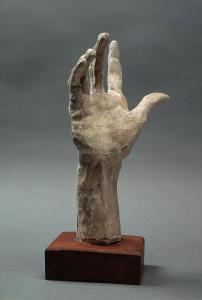“At Last, My Right Arm Is Complete”: the Dismembered Body and Sweeney Todd
There is a powerful moment on the original cast recording of Stephen Sondheim and Hugh Wheeler’s Sweeney Todd: the Demon Barber of Fleet Street. At the end of his song “My Friends”, Len Cariou, the actor playing Sweeney Todd, lifts his razor and says “At last, my arm is complete again.” This is the line as he said it in the show’s original run at the Uris Theatre in 1979, as well. (you can watch the whole thing on YouTube). This is not, however, the line as it was originally written. In the script, Sweeney says simply “My right arm is complete again.”
The explanation for the difference is a simple one. Len Cariou was a lefty. He held the razor aloft in his left hand, which meant that Sondheim rewrote the line, removing the word “right”, which, according to Sondheim “effectively takes the power out of the line.” Coming as it does between the song “My Friends” and the first reprise of “The Ballad of Sweeney Todd” this line has managed to make its way onto every recording of Sweeney. As it happens, Cariou’s replacement on Broadway, George Hearn, was also a southpaw. Hollywood’s Sweeney, Johnny Depp, and Michael Ball, who played Sweeney in a 2012 revival on the West End, also cut the “right” from the line. (Although ask the internet whether Johnny Depp is left handed and you will get only confusion in return).
I’ve become increasingly obsessed with Sweeney Todd’s completed right arm in the last several months. I see an echo, in this arm, of William Shakespeare’s tragic protagonist Titus Andronicus, a murderous revenger who bakes his enemies into a pie and feeds them to their mother. Andronicus, you’ll probably remember, is tricked into cutting off his own hand in order to save his sons’ lives – an action whose only effect is the behanding itself. It is as if Sweeney is Andronicus come back from the dead, and as if Sweeney’s razors somehow restored the arm of Shakespeare’s ancient Roman.
Today I want to talk about this arm of Sweeney’s and what dismemberment might mean in Sweeney Todd. I am going to make an argument that links revenge and dismemberment that is going to evolve into an argument about the pleasures of watching violence and witnessing dismemberment that I believe are at work for Sweeney Todd’s audiences.
Revenge, as it is for Titus Andronicus, is the driving force behind the plot of Sweeney Todd, but for what precisely is Sweeney getting vengeance? What justifies Sweeney’s violence and allows the audience to take pleasure in the vengeance he enacts?



